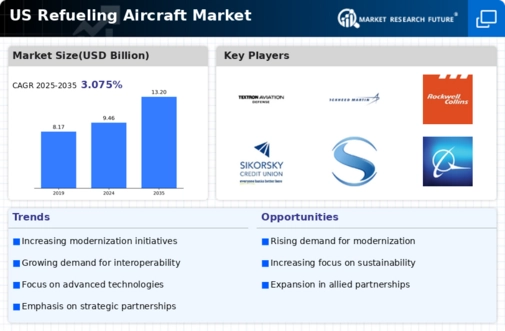Rising Demand for Aerial Refueling
The refueling aircraft market is experiencing a notable increase in demand due to the growing need for extended operational ranges in military missions. As military strategies evolve, the ability to refuel aircraft mid-air becomes crucial for maintaining air superiority. The U.S. Department of Defense has allocated approximately $10 billion for aerial refueling capabilities over the next decade, indicating a strong commitment to enhancing these operations. This investment is likely to drive innovation and modernization within the refueling aircraft market, as new technologies are developed to improve efficiency and effectiveness. Furthermore, the increasing frequency of joint military exercises and international operations necessitates a robust refueling infrastructure, further propelling the market forward.
Increased Focus on Operational Readiness
Operational readiness remains a top priority for the U.S. military, significantly impacting the refueling aircraft market. The need for aircraft to be mission-ready at all times drives investments in maintenance, upgrades, and training. The U.S. Air Force has reported that maintaining a fleet of refueling aircraft is essential for ensuring that air operations can be conducted without interruption. This focus on readiness translates into a consistent demand for advanced refueling solutions, as military planners seek to minimize downtime and maximize the effectiveness of their air fleets. Consequently, the refueling aircraft market is likely to see sustained growth as military budgets prioritize readiness-enhancing technologies.
Strategic Partnerships and Collaborations
Strategic partnerships between defense contractors and government agencies are becoming increasingly prevalent in the refueling aircraft market. These collaborations often lead to the sharing of resources, technology, and expertise, which can enhance the capabilities of refueling systems. For instance, recent agreements between major defense firms and the U.S. Air Force aim to streamline the development of next-generation refueling aircraft. Such partnerships not only facilitate innovation but also help in reducing costs associated with research and development. The refueling aircraft market is likely to benefit from these synergies, as they can lead to more efficient production processes and improved operational readiness for military forces.
Emerging Threats and Geopolitical Tensions
The current geopolitical landscape, characterized by emerging threats and regional conflicts, is influencing the refueling aircraft market. As tensions rise, the U.S. military is compelled to enhance its operational capabilities, including aerial refueling. The need for rapid deployment and sustained air operations in various theaters of conflict necessitates a robust refueling infrastructure. Recent assessments indicate that the U.S. military may increase its refueling aircraft fleet by up to 20% over the next five years to address these challenges. This strategic response to geopolitical dynamics is likely to drive growth in the refueling aircraft market, as defense budgets are adjusted to meet evolving security needs.
Advancements in Fuel Efficiency Technologies
Technological advancements in fuel efficiency are playing a pivotal role in shaping the refueling aircraft market. As environmental concerns gain prominence, the U.S. military is increasingly focused on reducing its carbon footprint while maintaining operational effectiveness. Innovations in fuel management systems and engine technologies are expected to enhance the efficiency of refueling operations. The integration of alternative fuels and hybrid systems may also emerge as viable options, aligning with sustainability goals. These advancements not only promise to lower operational costs but also contribute to the overall modernization of the refueling aircraft market, as military forces seek to balance performance with environmental responsibility.


















Leave a Comment